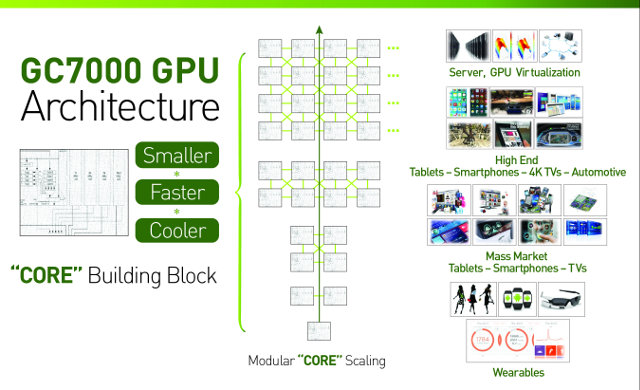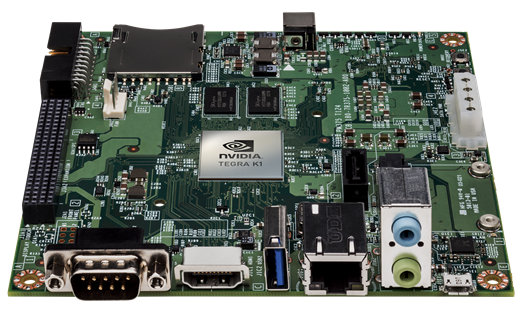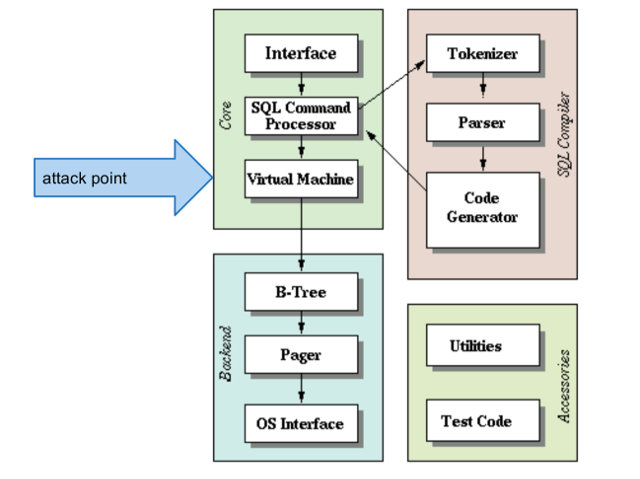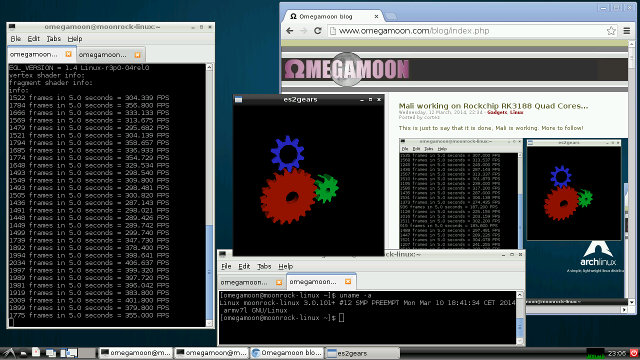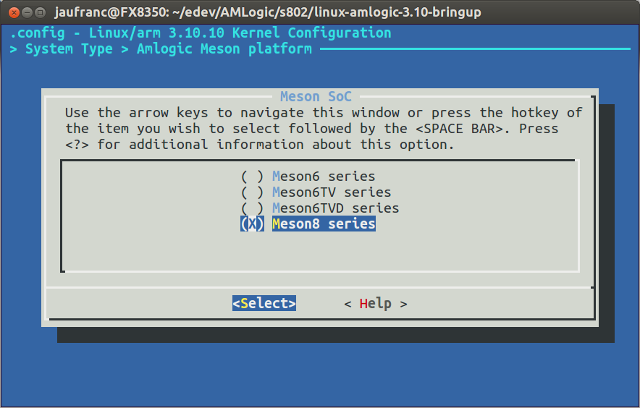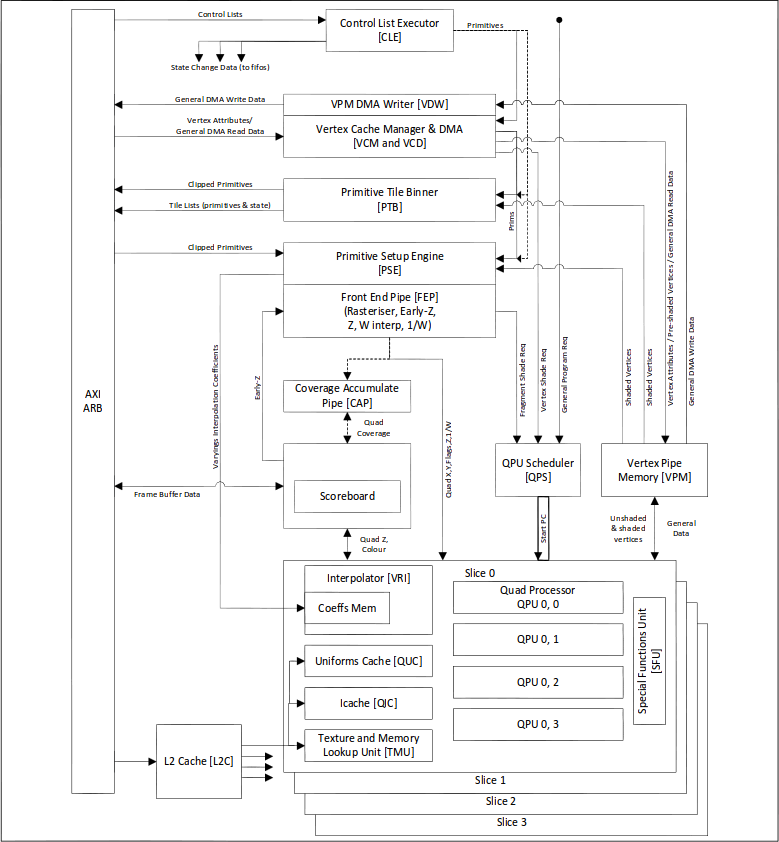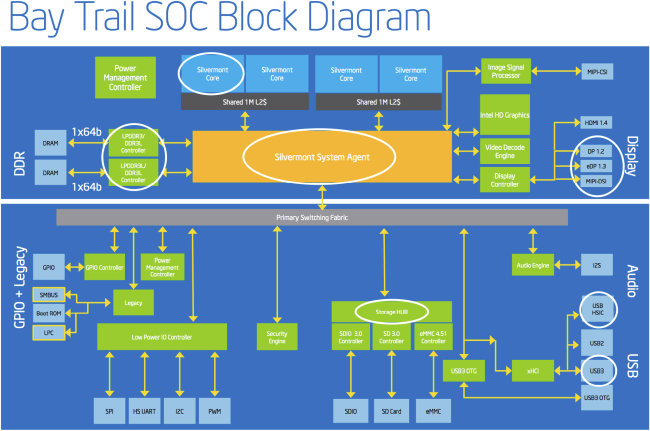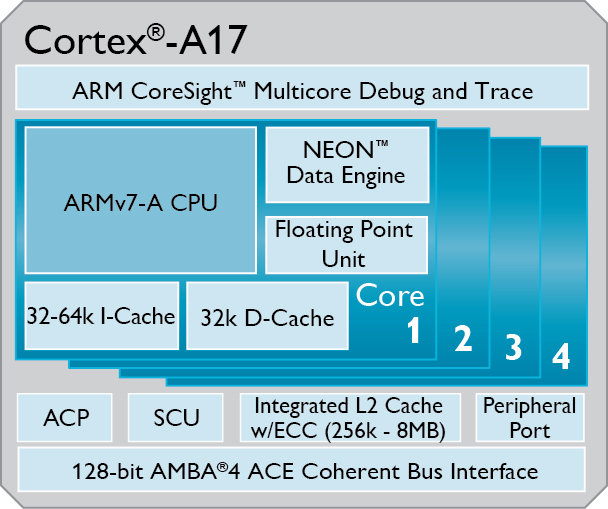Earlier this month, Vivante Corporation has announced several silicon partner integrations (but no names given) of its GC7000 Series GPU IP into SoCs targeting wearables, mobile, automotive, and 4K TV products, and provided some more details about its GC7000 family which supports features such as OpenGL ES 3.1 API, and hardware TS/GS/CS (tessellation / geometry / compute shader) extensions for Android. According to the company, they key benefits of their GC7000 GPU IP can be summarized as follows: True GPU Scalability – GC7000 Series products support limited silicon area to match form factor and market requirements. Products can snap to grid starting at 3.0 mm2 (28 nm) for the smallest single GPU GC7000 instance and grow in simple modular fashion for high end implementations to achieve what the company’s claims to be the the industry’s best PPA (power/performance/area). Smallest Licensable OpenGL ES 3.1 Cores with Geometry, Tessellation, and Compute Shaders […]
$192 Nvidia Jetson TK1 Development Board with Tegra K1 Quad Core Cortex A15 SoC
Nvidia has just unveiled Jetson TK1 development kit powered by their 32-bit Tegra K1 quad core Cortex A15 processor with a 192-core Kepler GPU. This board targets computer-vision applications for robotics, medical, avionics, and automotive industries that can leverage the compute capabilities of the Kepler GPU. Jetson TK1 devkit specifications: SoC – Nvidia Tegra K1 SoC with 4-Plus-1 quad-core ARM Cortex A15 CPU, and Kepler GPU with 192 CUDA cores (Model T124) System Memory – 2 GB x16 memory with 64 bit width Storage – 16 GB 4.51 eMMC memory, SATA data + power ports, full size SD/MMC slot, and 4MB SPI boot flash. Video Output – HDMI port Audio – ALC5639 Realtek Audio codec with Mic in and Line out Connectivity – RTL8111GS Realtek GigE LAN USB – 1x USB 2.0 OTG port, micro AB, 1x USB 3.0 port, A Debugging – RS232 serial port, JTAG Expansion 1x Half […]
OpenCL Accelerated SQL Database with ARM Mali GPU Compute Capabilities
We’ve previously seen GPU compute on ARM could improve performance for mobile, automotive and consumer electronics application. GPU compute offload CPU task that can be parallelized to the GPU using APIs such as OpenCL or RenderScript. Most applications that can leverage GPU compute are related to media processing (video decoding, picture processing, audio decoding, image reconigion, etc…), but one thing I did not suspect could be improve is database access. That’s what Tom Gall, Linaro, has achieved in a side project by using OpenCL to accelerate SQLite database operations by around 4 times for a given benchmark. The hardware used was a Samsung Chromebook with an Exynos 5250 SoC featurig a dual core Cortex A15 processor and an ARM Mali T604 GPU. CPU compute is only possible on ARM Mali T6xx and greater, and won’t work on Mali 400 / 450 GPUs. Other GPU vendors such as Vivante and Imagination […]
Mali-400 GPU Is Now Working in Linux for Rockchip RK3188 Devices
Accelerated 3D graphics in Linux with Mali-400 via OpenGL ES has been possible for nearly a year on RK3066 devices, but there was no such support for RK3188. This week however, both Naoki FUKAUMI and omegamoon have reported OpenGL ES to work in in their respective RK3188 devices. I don’t know which device omegamoon used, but Naoki did so in Radxa Rock, and even posted instructions to build it yourself. They’ve mostly followed the work done by olegk0 for Rockchip, and Mali drivers build instructions provided in linux-sunxi community, and it can be summarize in 3 main steps: Cross-compile drm.ko, mali_drm.ko, ump.ko, mali.ko in a Linux machine Copy and load the four modules to your RK3188 based board or device. Install dependencies and binary Mali drivers from sunxi-linux in your Rockchip device Once this is done you can try some OpenGL ES demos such as esgears2 or glmark2-es to test […]
Amlogic GPL Source Code Release – Kernel 3.10, U-Boot, and Drivers (Wi-Fi, NAND, TVIN, Mali GPU)
Last month, I noticed Amlogic provided links to the Android SDK for S802 / M802 on their open source website, but the only way to get the source was to share your SSH public with Amlogic, so that they give you access. It did not happen, but the company has released the source for Linux 3.10.10, U-boot 2011.03, Realtek and Broadcom Wi-Fi drivers, NAND drivers, “TVIN”drivers, and kernel space GPU drivers for Mali-400 / 450 GPU. There are also some customer board files for Meson 6 only (AML8726-MX / M6) but they do not seem to match the kernel… If you want to build the kernel, including the drivers, you’ll need to download a bunch of files: wget http://openlinux.amlogic.com:8000/download/ARM/kernel/arm-src-kernel-2014-03-06-d5d0557b2b.tar.gz wget http://openlinux.amlogic.com:8000/download/ARM/wifi/rtk8192du-2014-03-06-7f70d95d29.tar.gz wget http://openlinux.amlogic.com:8000/download/ARM/wifi/rtk8192eu-2014-03-06-9766866350.tar.gz wget http://openlinux.amlogic.com:8000/download/ARM/wifi/rtk8192cu-2014-03-06-54bde7d73d.tar.gz wget http://openlinux.amlogic.com:8000/download/ARM/wifi/rtk8188eu-2014-03-06-2462231f02.tar.gz wget http://openlinux.amlogic.com:8000/download/ARM/wifi/brcmap6xxx-2014-03-06-302aca1a31.tar.gz wget http://openlinux.amlogic.com:8000/download/ARM/wifi/wifi-fw-2014-03-06-d3b2263640.tar.gz wget http://openlinux.amlogic.com:8000/download/ARM/modules/aml_tvin-2014-03-06-fb3ba6b1c8.tar.gz wget http://openlinux.amlogic.com:8000/download/ARM/modules/aml_nand-2014-03-06-39095c4296.tar.gz wget http://openlinux.amlogic.com:8000/download/ARM/customer/aml_customer-2014-03-06-76ce689191.tar.gz wget http://openlinux.amlogic.com:8000/download/ARM/gpu/gpu-2014-03-06-0425a1f681.tar.gz You’ll need to extract these tarballs in specific directories:
|
1 2 3 4 5 6 7 8 9 10 11 12 13 14 15 16 17 18 19 20 21 22 23 24 25 26 |
tar xvf arm-src-kernel-2014-03-06-d5d0557b2b.tar.gz mkdir -p hardware/amlogic/ mkdir -p hardware/wifi/realtek/drivers mkdir -p hardware/wifi/broadcom/drivers mkdir -p hardware/arm/ cd hardware/amlogic tar xvf ../../../aml_nand-2014-03-06-39095c4296.tar.gz mv aml_nand-amlogic-nand nand cd ../wifi/realtek/drivers tar xvf ../../../../rtk8192du-2014-03-06-7f70d95d29.tar.gz tar xvf ../../../../rtk8192eu-2014-03-06-9766866350.tar.gz tar xvf ../../../../rtk8192cu-2014-03-06-54bde7d73d.tar.gz tar xvf ../../../../rtk8188eu-2014-03-06-2462231f02.tar.gz mv rtk8188eu-8188eu 8188eu mv rtk8192du-8192du 8192du mv rtk8192cu-8192cu 8192cu mv rtk8192eu-8192eu 8192eu cd ../../broadcom/drivers tar xvf ../../../../brcmap6xxx-2014-03-06-302aca1a31.tar.gz mv brcmap6xxx-ap6xxx ap6xxx cd ../../../arm tar xvf ../../gpu-2014-03-06-0425a1f681.tar.gz mv gpu-r3p2-01rel3 gpu cd .. tar xvf ../../aml_tvin-2014-03-06-fb3ba6b1c8.tar.gz mv aml_tvin-amlogic-3.10-bringup tvin |
You […]
Raspberry Pi Gets Open Source 3D Graphics Drivers and Documentation
The Raspberry Pi was launched 2 years ago, and for its birthday, Broadcom decided to release documentation and open source OpenGL ES 1.1 and 2.0 driver for the Videocore IV GPU. You may remember the Raspberry Pi Foundation already release an open source GPU driver in 2012, but this was only for the part running on the ARM11 core for Broadcom BCM2835 SoC, which is just a few hundred lines of code long, and communicates with a binary blob which does all the work in the GPU itself. This new release however goes much further with a 111 page document entitled “VideoCore IV 3D Architecture Reference Guide“, and open source driver for the 3D System of the GPU. Strangely the release is however not for BCM2835, but instead BCM21553. Broadcom clearly has the source for BCM2835 too, so this must have been made for legal reasons. VideoCoreIV packs a lot […]
Intel Bay Trail Graphics Overview – FOSDEM 2014
Bay Trail SoCs are new low power Intel ICs for tablets (Bay Trail-T, Z3000 series), mobiles (Bay Trail-M, N2800, N2900 and N3500 series), desktops (Bay Trail-D, J1800, J1900 and J2900 series) and embedded / industrial platforms (Bay Trail-I, E3800 series). Many Atom processors used to features PowerVR GPU, but it has now been replaced by Intel HD graphics in Bay Trail SoC. Jesse Barnes, working at Intel on software and drivers for Intel graphics devices, gives a presentation about Bay Trail SoCs with a focus on graphics. After an overview, and some ARM bashing regarding performance (Nvidia Tegra 4 and Qualcomm Snapdragon 800), and even power consumption (Tegra 4 only), he describe further details about Intel HD graphics found in the new Intel processors. Everything is basically in mainline, and you’ll need Linux 3.10 or greater, Mesa 9.2 or greater, and libva 1.2.1 or greater for proper support. Some initial […]
ARM Unveils Cortex A17 Processor, First Used in Mediatek MT6595 and Rockchip RK3288 SoCs
Finally all these ARM Cortex A17 marketing materials for Rockchip RK3288 were not some typos, but Rockchip marketing team may just have not received the memo reading “Confidential”, as ARM has now officially announced Cortex A17 processor based on ARMv7-A architecture, with support for big.LITTLE with Cortex A7, and that can be coupled with Mali-T720 mid-range GPU and Mali-V500 VPU. After Cortex A15, and Cortex A12, you may wonder “Why? But Why did ARM had to launch yet another new core?”. Here’s the company answer to that question: The Cortex-A17 processor offers 60% performance uplift over the Cortex-A9 processor, the current leader in mid-range mobile market, and betters the best efficiency enabling optimized solutions to address existing and new products. The Cortex-A17 processor is based on the popular ARMv7-A architecture, today’s most successful architecture in the mobile market. With over 1M apps supporting the ARMv7-A architecture, the Cortex-A17 processor is […]


